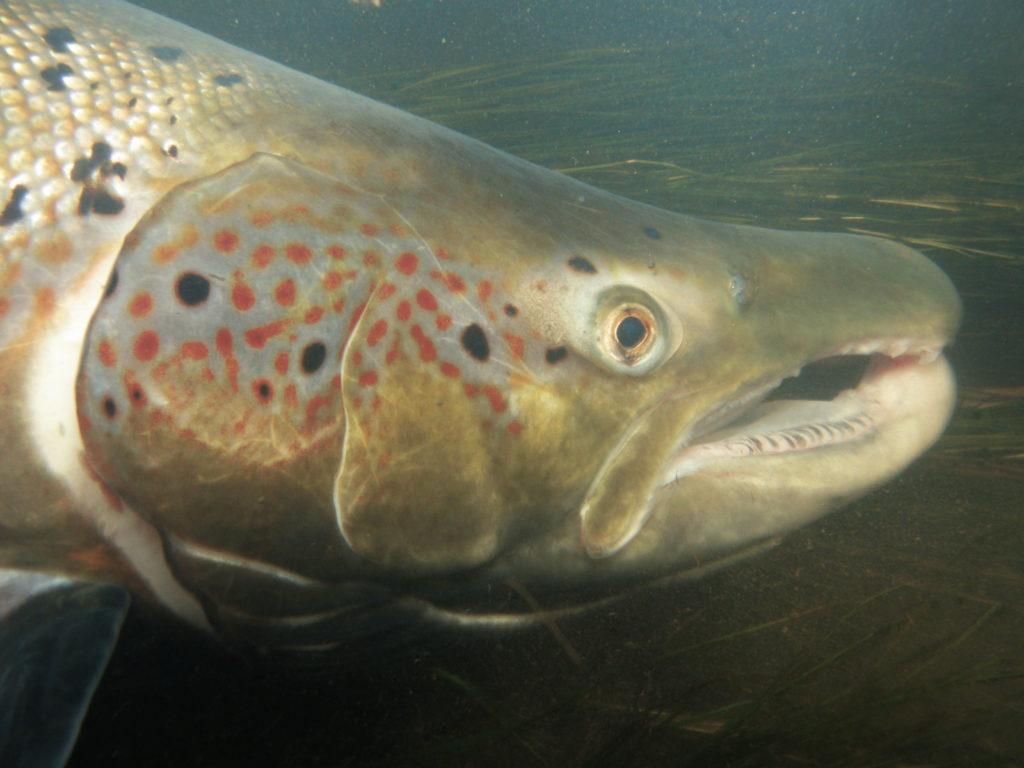Migratory Species
Migratory fish are species that undergo periodical migrations. Fish that migrate to spawn can be divided to anadromous and catadromous species. Anadromous species live and feed mostly in the sea and migrate to fresh water to breed, whereas catadromous species live mostly in lakes or rivers and migrate to sea to breed.
Baltic anadromous fish include Atlantic salmon (Salmo salar), sea trout (Salmo trutta), whitefish or powan (Coregonus species), vimba bream (Vimba vimba), river lamprey (Lampetra fluviatilis), grayling (Thymallus thymallus) and smelt (Osmerus eperlanus). The catadromous European eel (Anguilla anguilla) migrates a long way from the Sargasso Sea in North West Atlantic into the Baltic Sea area rivers and lakes as a juvenile and back as an adult but is at present very scarce due to human activities and damming.

Wild salmon male (Salmo salar). Photo: Saulius Stakenas.
In the Baltic Sea Action Plan, the Contracting Parties have agreed to develop national programmes for the conservation of eel stocks as a contribution to a Baltic co-ordinated programme to ensure successful eel migrations from the Baltic Sea drainage basin to natural spawning grounds. For the EU Member States thus implementing the EC Regulation No. 1100/2007 establishing measures for the recovery of the stock of European eel, by 2008.
They also agreed to implement the classification and inventorying of rivers with historic and existing migratory fish species (e.g. salmon, eel, sea trout and sturgeon), no later than by 2012. The development of restoration plans (including restoration of spawning sites and migration routes) in suitable rivers to reinstate migratory fish species, should be completed by 2010.
They also concur that the active conservation of at least ten endangered/threatened wild salmon river populations in the Baltic Sea region as well as the reintroduction of native Baltic Sea salmon in at least four potential salmon rivers, should be achieved by 2009.
Moreover, to enhance restoration of lost biodiversity, they agreed to join and/or support Poland and Germany in reintroducing Baltic sturgeon to its potential spawning rivers.
The Contracting Parties also urge the competent fisheries authorities in co-operation with the Baltic RAC and HELCOM to take immediate actions for the further development and application in all cases of appropriate breeding and restocking practices for salmon and sea trout to safeguard the genetic variability of native wild stocks, by 2012 and also to take actions for rapid implementation of the existing long-term management plans for cod and eel, not later than by 2012 to improve their distribution size/age-range.
In the 2013 HELCOM Ministerial Declaration, the contracting parties noted the regional perspective in the European Commission proposal for a multi-annual plan for the Baltic salmon stock and its targets onprotection and restoration of riverine habitats and populations based on HELCOM results and the scientific advice from ICES;
Contracting Paries are aware that many of the Baltic salmon and sea trout stocks are unlikely to achieve MSY by 2015, therefore they agreed toprioritise and intensify implementation of HELCOM BSAP (2007) conservation goals for the Baltic salmon and sea trout to be met by 2015, based on HELCOM Recommendation 32-33/1 “Conservation of Baltic Salmon (Salmo salar) and Sea Trout (Salmo trutta) populations by the restoration of their river habitats and management of river fisheries”, and the upcoming EU multi-annual plan for the Baltic salmon stock and the fisheries exploiting that stock (as applicable to EU Member States), through exchange of best practices, knowledge and experiences on regional level, as well as follow-up initiatives addressing salmon and sea trout restoration activities and further development and implementation, by 2015 and onwards, in co-operation with ICES, of:
- common practices for breeding, rearing and releasing salmon and sea trout as reintroductions in potential salmonid rivers;
- investigations of needed improvements for stocking practices (e.g. biological and genetical guidelines);
- recommendations for riverine and estuarine management and conservation measures, such as fish ways for up and down migration, restoration and protection of spawning grounds, concerning fisheries within rivers and estuaries;
- comparable methodology for data collection through surveys, especially on recreational fisheries;”
In the Declaration, Contracting Parties show concern for the critical status of European eel and the fact that fisheries management and other measures undertaken by individual countries have not yet shown any significant improvement in the status of eel. Therefore, they agreed to continue the efforts underway and enhance co-ordination of measures within the Baltic Sea as well as with other European countries, for the conservation of eel stocks, in line with national eel management plans and to consider additional measures if necessary, such as reducing fishing mortality in accordance with the ICES Advice, removing migration barriers, and re-stocking in eel-safe river systems, e.g. utilising the outcomes of co-operation between ICES, HELCOM and other stakeholders on this issue.In the Declaration the ministers and the commissioner also decided to protectsturgeon through supporting the HELCOM project on Baltic sturgeon remediation as well as raise public awareness concerning re-introduction of sturgeon among fishermen, other relevant stakeholders and the public.

